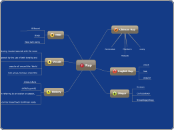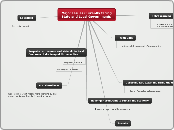Acknowledging the importance of human emotions in crime, punishment and social control is a first step in countering the mechanistic crank of orthodox criminology.
Section B, Question 1: Cultural Criminology and understanding Racially Motivated Violence
This mindmap relates to Section B, Question 1: Cultural Criminology
The focus of the question will be to explore the area of Cultural Criminology which seeks to explain crime and criminal behaviour and its control in terms of culture and the agencies and institutions of crime control as cultural products or as creative constructs. As such they must be read in terms of the meanings they carry. The focus of the field is broad, comprising situated and symbolic meaning; constructed social identity; subcultural analysis.
The aim is to explore:
- The approaches to crime which dominate orthodox criminological theory: Rational Choice Theory and Sociological Positivism.
- The theoretical opposition to such approaches to crime, Cultural Criminology.
- The importance of understanding the internal psychic-emotive processes, structural inequality and injustice when attempting to explain vivid emotional or ‘expressive’ elements.
- Chaotic, violent and ‘expressive’ crimes that create distress and community disharmony such as ‘hate crime’ and ‘racially aggravated violence’.
CONCLUSION
RECAP
Reasoning
Content
Context
Objectives
Aims
CRITICAL EVALUATION
'Losing the Race' (Gadd and Dixon, 2011):
Katz (1999:1) suggests when shame or rage flood through experience, where is the source of the inundation, where are the gates that let the rush of feelings come through, if they are not within?
These are the foreground experiences of the actor and the other background experiences such as social class, gender, ethnicity.
and that the complexities of both must be considered and taken seriously.
Gadd and Jefferson (2007) draw on the work of Frosch (2003) when explaining the psychosocial approach as one that understands human subjects as ‘simultaneously, the products of their own unique psychic worlds and a shared social world’ (Frosch, 2003),
Few people, including most of those convicted of racially aggravated crimes, see themselves as ‘racists’.
Indeed, they often feel disrespected and believe that they are the principal victims of racial discrimination.
The presence of migrant and minority ethnic populations is commonly seen in North Staffordshire as the cause of decline, and an uncomfortable reminder of local white people's inability to secure decent lives for themselves and their families.
Yet many white people associate immigration, and the descendants of immigrants, with everything that is wrong with their lives.
They believe that ‘politically correct’ anti-racist initiatives put them at a disadvantage when compared to their minority ethnic neighbours.
The vast majority do not condone racist attacks.
The research found that thinking and talking in terms of ‘us’ and ‘them’, people who belong and people who do not, is common among people of all ages in Stoke-on-Trent and North Staffordshire.
Industrial decline and social change have led to a widely felt sense of loss, a sense that a whole way of life has gone, never to return.
For many people in North Staffordshire, the present is unsettling and the future uncertain:
They reveal an environment suffering the loss of socio-economic status,
The ‘othering’ of racially motivated offenders has served to construct a separate identity of ‘racism’ existing in juxtaposition to the common forms of ‘racist sentiments’ evidence in everyday actions.
CRITICAL ANALYSIS
Rise in Hate Crime
Context and Motive in the Perpetration of Racially Motivated Violence and Harassment’ (Gadd et al, 2011).
Explored the nexus between deeply personal motivations and the loss of economic, cultural and emotional status,
Contribute to debates about the relationships between offenders’ motivations, popular opinion, the socio-economic histories of particular places.
Elicit the opinions of groups of local people using focus group discussions.
Obtain and analyse the life-stories of a sample of offenders implicated in perpetrating acts of racial harassment.
The aim was to explore the connections and tensions between pervasive forms of racism and xenophobia, anti-racist sentiments and the motivations of those who perpetrate RMO.
Criminology hasn’t paid sustained attention to the subject of emotions:
The social construction and significance of the emotions is now being recognised through a revival of interest in psychoanalytic theory (Vanstone, 2004)
A revival of interest in emotions rather than cognitive processes as sources of action (Katz, 1988; Scheff, 1994, 1997) .
Autobiographical narrative in understanding desistance (Maruna, 2000; Maruna et al., 2004);
It’s sense of a fractured and unstable ‘postmodern identity’ (Jefferson, 1994; 2002a);
Recent figures estimate:
“52,528 hate crimes recorded by the police, an increase of 18 per cent compared with the 44,471 hate crimes recorded in 2013/14” (Home Office, 2015:1).
Of which, the incidence of hate crime monitored by strand, Smith (et al, 2012) suggests the ‘offender’s attitude to the victim’s race’ represents the strand most commonly perceived as an offender’s motivation.
Most cited work has tended to be typological:
Not all racially motivated offenders are all the same, that motives and rationales vary and that offences aggravated by the use of racist terms are not always initiated because of hateful feelings.
Messner, McHugh and Felson (2004) ‘versatile (generalist) offenders tinged with ‘bias’, and ‘specialist hate crime offenders’
Berk, Boyd and Hamner (2003) ‘expressive’ and ‘instrumental’ motives
.
McDevitt, Levin and Bennett, (2003) proposed ‘thrill’, ‘defensive’, ‘retaliatory’, ‘mission’ motivated offenders.
The acknowledgement of hate crime as socio-legal problem (Green, McFalls & Smith, 2001)
Bowling was of the opinion that “while the most basic descriptions have been formulated, they remain something of an effigy in the criminological literature” (1999:163).
Daily news reports of a growing tide of racially-aggravated incidents with people of a different racial heritage becoming the increasing target of abuse.
Are there any benefits to capturing the oral narratives of racially motivated offenders?
What motivates such hate?
DESCRIPTION
Cultural criminology- theoretical and interventionist approach which seeks to understand crime in the context of its culture
Against the abstracted, mechanistic rational calculator,
Cultural criminology counterposes the naturalism of crime itself.
Wright and Decker (1994:117) found that many burglars are committed not just to the property acquisition but to the ‘quest for excitement’ and ‘illicit action’.
Katz (1988) ‘Seductions of Crime’:
The study of crime has been preoccupied with a search for background forces, usually defects in the offenders' psychological backgrounds or social environments, to the neglect of the positive.
Emotions are viewed as incorporating three dimensions:
Corporeal (physical body)
Cognitive
Feeling/Affect
The lived experience of committing crime, of concluding a criminal act, of being victimised by crime.
Many examples of such chaotic, violent and expressive crimes
It is these emotionally charged state that interests cultural criminologists.
The subjective emotions and textured socio-cultural dynamics which animate many crimes, and increasingly so under late modern conditions.
Set against this current theoretical climate, are the growing number of crimes that embody vivid emotional or ‘expressive’ elements-
What Hayward (2004) refers to as the crimes of the ‘irrational actor’.
In place of messily complex human subjects shot through with anxiety and self doubt, conflictual feelings and unruly desires we are offered depleted caricatures: individuals shorn of their social context, or who act, we are told, purely on the basis of reason or choice, interested only in the maximisation of utility” (2007:1).
Orthodox Criminology (Positivism and Classicism) -
Considered to embody simple rational/instrumental narratives.
We are left with a desperately thin narrative, where intensities of motivation, feelings of humiliation and rage, even love and solidarity are all foresworn.
INTRODUCTION
REASONING
CONTENT
CONTEXT
OBJECTIVE
AIMS









